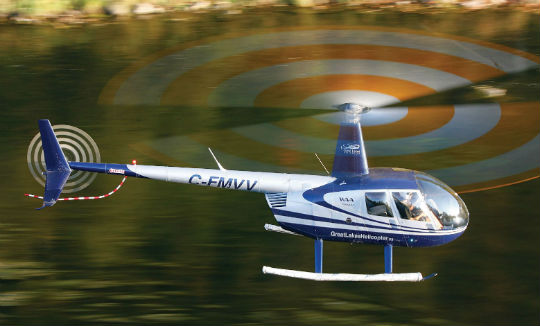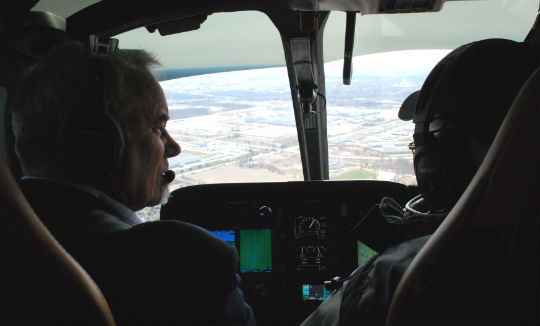
Some students return frequently, committed to staying sharp with help from voluntary recurrent training. But there are some faces he never sees again.
“We know there’s a lot of private pilots out there that don’t do any kind of annual training or recurrent training,” said Tatsula, a Class 1 flight instructor with more than 4,000 flight hours in both turbine and piston aircraft.
“Some of them … fly regularly, they’re up to speed, they’re current and all that, but they don’t do the emergency side of things,” he added. “We always tell them, ‘Once you graduate you’re taking friends, family, children for rides.’
“Everyone’s going to want to go for a ride. Who doesn’t want to go for a ride in a helicopter, right?”
While safety is top of mind for many pilots, regulatory requirements in Canada make it possible to go up to two years without taking part in recurrent training. At that point, Transport Canada requires pilots to choose one activity from a list that includes attending a safety seminar, participating in an approved recurrent training program and completing a flight review with an instructor.
Pilots may also complete a self-paced study program; a training program or pilot proficiency check (PPC); a written exam; or the requirements for the issue or renewal of a license, permit or rating.
All pilots who wish to carry passengers must also complete at least five takeoffs and five landings every six months in the category and class of aircraft in which the passenger is carried. Pilots who wish to carry passengers at night must also complete five takeoffs and landings at night every six months.
And pilots must fly as pilot-in-command or co-pilot at least once every five years in a category of aircraft for which they are licensed. Pilots who don’t meet this requirement are required to successfully complete a flight review with an instructor and pass an examination.
Many commercial pilots take recurrent training on an annual basis, and many fly nearly every day. But private pilots sometimes fly less often, making it possible to become rusty or develop bad habits.
“I think private pilots tend to fly infrequently,” said Bill Leyburne, president of Great Lakes Helicopter. “The average I see is really less than 50 hours a year. A lot of them only fly 30 hours a year or even less.
“And their skills — you know, they deteriorate a little bit, like everybody’s, over time. And they’re not encouraged to practice these things on their own, but with an instructor, I think it’s a good idea for anyone who flies to get out and do some recurrent training.”
With that in mind, the flight school hosted a fly-in open house at the Region of Waterloo International Airport on April 9, 2016, with the goal of encouraging pilots to embrace the idea of recurrent training.
It was an informal gathering that gave pilots the chance to swap stories and learn from one another, as well as instructors at the flight school. They also had the chance to take part in in-flight recurrent training exercises.
“This is the first event that we’ve done where we purposely try to get people in and make sure that they get the training done,” said Jo Anne Leyburne, general manager at Great Lakes Helicopter.
“It’s like anything else. You kind of lose your sense of safety sometimes and forget some of the basic essentials of flying.”

There are plans to make it an annual event, with the goal of creating a culture in Southern Ontario that’s receptive to recurrent training and improving the safety of all who fly.
“Up here [in Canada], there’s nothing other than common sense driving someone to do it,” said Gary Krebs, chief test pilot for Airbus Helicopters Canada in Fort Erie, Ont., who attended the event and took visitors on short flights in an Airbus H130.
“So I’m not opposed to something pushing private pilots in general, to training.”
The idea of recurrent training for private pilots also had traction with Richard G.H. Arlie, Bell Helicopter’s regional sales manager for Central Canada.
“Absolutely essential,” he said in an interview at the event. “Some of these things that happen, you need to react and you need to react with your reflexes.”
Marcus Vogel, a commercial pilot with Big Blue Air Services in Collingwood, Ont., said similar things.
“You definitely need to do it,” he said, soon after landing in Waterloo with his Robinson R66. “You’ve got to be ready to handle anything that comes at you, so the more training you can do, the better.”
Claude Larue, a long-time fixed-wing pilot who got his private helicopter license two years ago, also touted the importance of staying sharp.
“If you have the right training, then you’re going to be able to react, and basically just have to go and see the chiropractor when you get off the ground instead of the hospital,” he said.
While Tatsula doesn’t see resistance to the idea of recurrent training among private helicopter pilots, convenience is a concern.
“The private owners, I find, are generally busy business people, or somebody who has a very busy life,” he said.
“And the idea to take time out of that to come and train, it might be the resisting factor.”
As for what should be required under formal regulations, Tatsula said that’s a tough call.
“Some of the guys are very diligent and they do their own currency,” he said. “They do a check every year.
“I’d like to see them, once a year, have to do something.
“Whether it’s something like what I’m trying to make here, just a social thing where you come in and do an hour of training or 45 minutes.”
Ultimately, it’s about ensuring the safety of all who fly. The more pilots who attend an event like the one in Waterloo, the greater the opportunity to change mindsets and help them through difficult situations.
“The more pilots we have here, the odds are we’ll reach one of them or many of them or all of them, who knows? And hopefully save an accident or incident down the road.”









